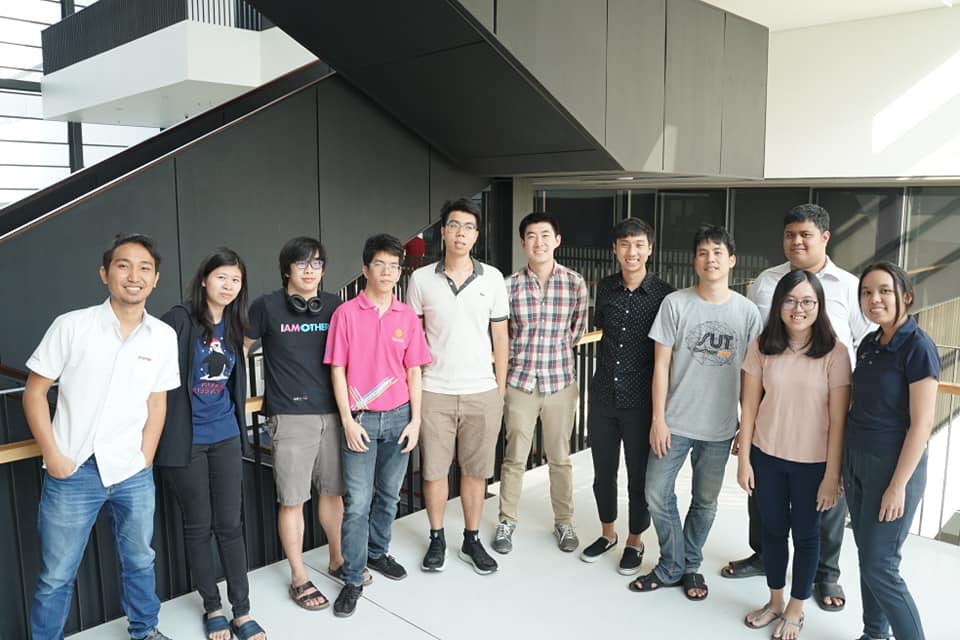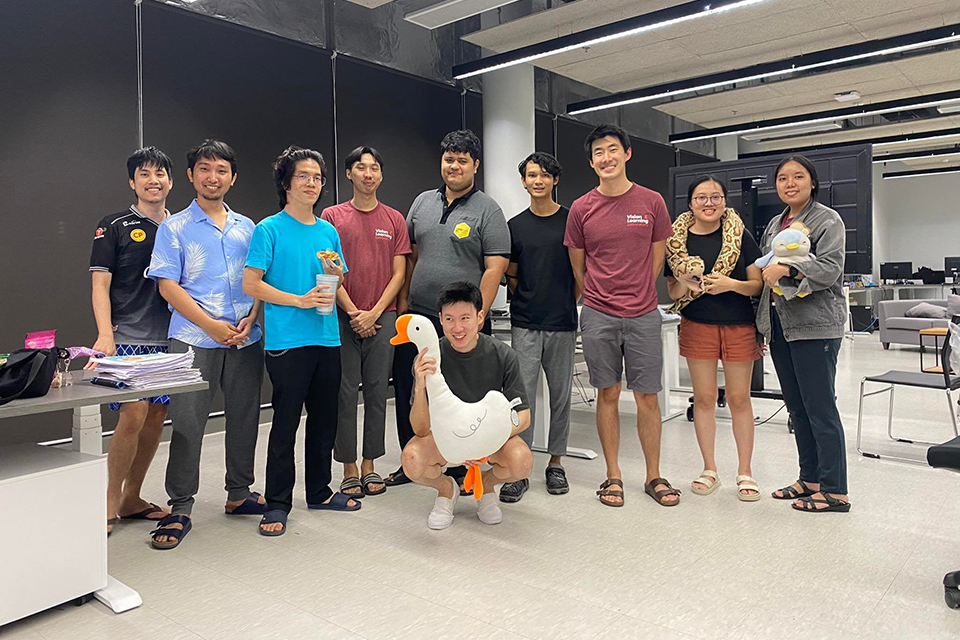Vision and Learning Lab

2019

2021
Our research team focuses on computer vision, deep learning, and computer graphics. Research areas include 3D reconstruction, image-based rendering, image and video synthesis, object localization using millimeter-wave radar, unsupervised deep learning, video forgery detection.
We are looking for students, RAs/interns, postdocs, and collaborators. If you’re interested, please directly contact supasorn@gmail.com
Our Members
Faculty Member
Lab Administrator
- Onarin Lapvetee (อรอลิน ลาภเวที)
- Kwanchat Potcharawongsakul (ขวัญฉัตร พชรวงศ์สกุล)
Research Assistants
- Jiraphon Yenphraphai (จิรพนธ์ เย็นพระพาย)
- Konpat Preechakul (กรพัฒน์ ปรีชากุล)
- Nattanat Chatthee (ณัฐณัฏฐ์ ฉัตรถี)
PhD students
- Nakorn Kumchaiseemak (ณกรณ์ ขำชัยสีเมฆ)
- Nontawat Tritrong (นนทวัชร ตริตรอง)
- Norawit Urailertprasert (นรวิชญ์ อุไรเลิศประเสริฐ)
- Pakkapon Phongthawee (ภัคพล พงษ์ทวี)
- Pattaramanee Arsomngern (ภัทรมณี อาศรมเงิน)
- Pantawat Ponglertnapakorn (พันธวัตถ์ พงศ์เลิศนภากร)
- Pitchaporn Rewatbowornwong (พิชชาพร เรวัตบวรวงศ์)
- Sasikarn Khwanmuang (ศศิกาญจน์ ขวัญเมือง)
- Suttisak Wizadwongsa (สุทธิศักดิ์ วิเศษวงษา)
- Palakon Kotchapansompote (พลากร คชพันธ์สมโภชน์)
- Nontaphat Sinsunthithet (นนทพัทธ์ สินสันธิเทศ)
Research topics
3D Light-field Reconstruction
We explore the problem of view synthesis which allows for the generation of new views of objects or scenes from a set of sparse input images. We focus on objects with complex appearances such as glass or fluffy objects with thin structures that foil state-of-the-art techniques for 3D reconstruction. Our ultimate goal is to build a tool that can visualize any object in a Virtual Reality (VR) or Augmented Reality (AR) headset with a true 3D parallax as well as on any desktop and mobile phone in real-time. Main applications include displaying products for online e-commerce and digitizing artifacts.
Solving this requires understanding the 3D scene from 2D images and a new efficient, compact representation that supports real-time rendering. Challenges include handling view-dependent effects such as those from a glossy surface, occlusions, and depth uncertainty. We’re addressing these with a practical and robust deep learning solution.
Improve the quality of Time-Lapse Reconstruction from Internet Photos
Recently, Ricardo Martin et al. shows how one can build a time-lapse from internet photos of a landmark taken by different people at different times and locations. The results were awe-inspiring and even showed some surprising changes that could never be noticed otherwise. However, real-world scenes are dynamic, filled with constantly-changing building structures, moving trees, and energetic crowds of visiting tourists. Unfortunately, these non-stationary parts of the scene lead to unrealistic and blurry time-lapse videos. We aim to improve upon the resolution, sharpness, temporal smoothness, and realism of the current state of the art, with a direct collaboration with Dr. Ricardo Martin.
Unsupervised Landmark Detection via Spatial Reasoning
Detecting visual landmarks or keypoints is a crucial component in many vision applications such as robot localization, object detection & retrieval, 3D reconstruction. However, building state-of-the-art detectors often require collecting and manually annotating a dataset which is expensive and time-consuming. We ask: Is it possible to leverage some form of spatial reasoning to automatically build a detector that is not only cheaper to build but also outperforms those that require human annotations for downstream tasks? Here we explore the idea of collaborative dual network training that learns to select and detect landmarks in an unsupervised fashion.
Tracing the Source of DeepFake
DeepFake can be used in many harmful ways, for example, delivery misleading political speeches, cyberbullying, etc. What is DeepFake? It is a video of a person generated by an “AI”(Face2Face, FaceSwap, DeepFake) which could be made to say new things or act arbitrarily. To generate a new DeepFake video, most AI methods require a real video of the person as a source content to synthesize a new speech. The ability to reliably retrieve the original source of a DeepFake could provide evidence for the inauthenticity of a video in question, particularly for public figures whose video clips are commonly accessible. Our goal is to develop a system that can index online videos and perform video retrieval to help combating the misuse of DeepFake videos.
Set Representation Learning for Retrieval Task
Set is a type of data that naturally arises in real-world and defines a collection of things, such as a set objects in an image or a set of 3D points (“point cloud”) captured from a laser scanner. Utilizing these sets with modern techniques such as Deep Learning turns out to be challenging because the set has a property called permutation invariance (which means the elements in the set can be swapped around without affecting what the set represents) and traditional neural networks treat each set element’s position differently. In this project, we aim to design a network that can handle set input correctly, thus allowing set to be more widely used for other several tasks like classification, retrieval, and segmentation.
RADAR as a non-contact sensor
Weather NEWS reports is an example of how we utilize RADAR, RAdio Detection And Ranging, in our daily life; arrays of radio station send radio wave to the cloud; the reflected raw signal is processed, and a cloud map frame can be reconstructed. The cloud motion trend can be interpreted from the consecutive frames. RADAR is not about the traditional use like weather forecast anymore
At the same time, with the on-going COVID-19 pandemic, the world has been adapting to the new normal way of living, with social distancing one of the main prevention to the spread of the deadly SAR-CoV-2 virus, while the vaccine is being developed.
At Vision and Learning Lab, we explore Machine Learning Techniques for RADAR signal recognition for non-contact measurements. We experiment on Impulsed, and Continuous Wave RADAR hardwares with applications ranging from health monitoring, and abnormal respiratory symptom detections, to non-destructive material inspections. We have internal collaborations with VISTEC’s Interfaces Lab, and externally with Thailand’s National Electronics and Computer Technology Center.
Publications
“Discovery of Latent 3D Keypoints via End-to-end Geometric Reasoning”, S. Suwajanakorn, N. Snavely, J. Tompson, M. Norouzi, NIPS 2018 (oral).